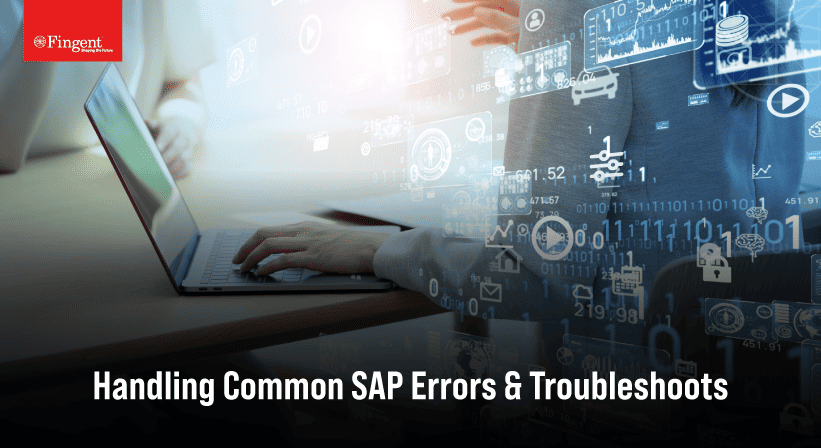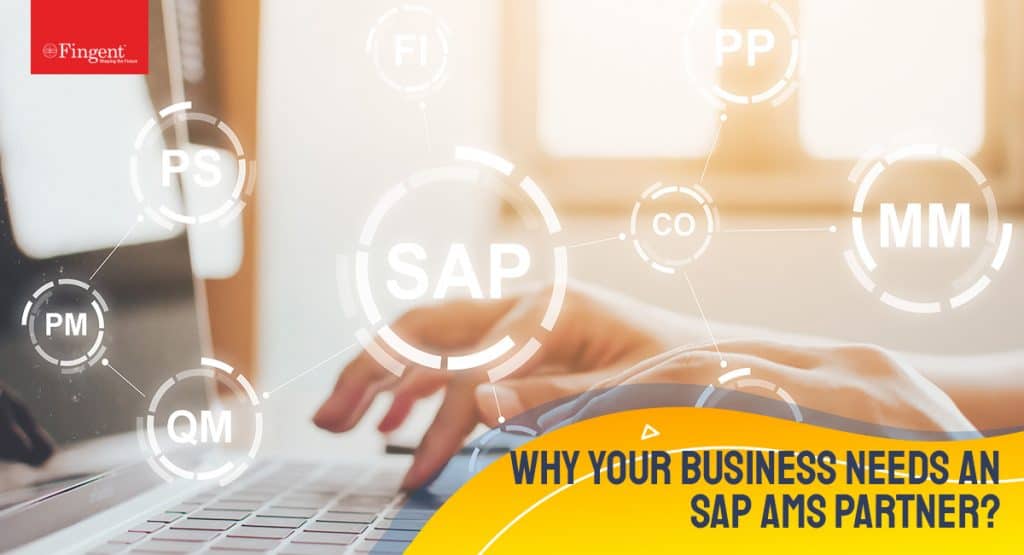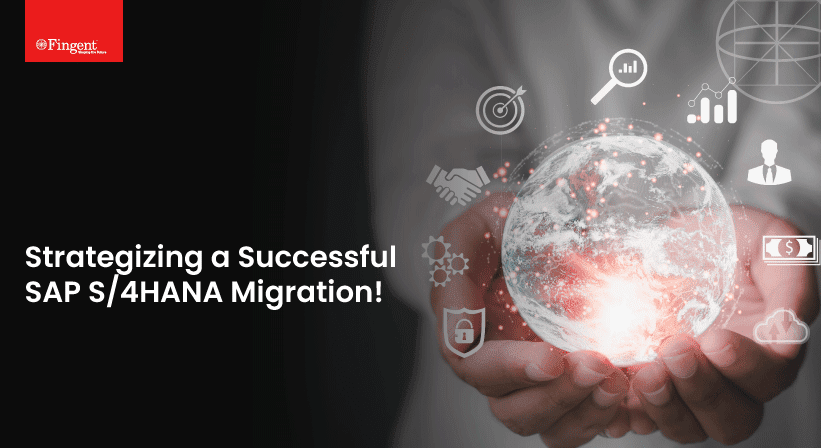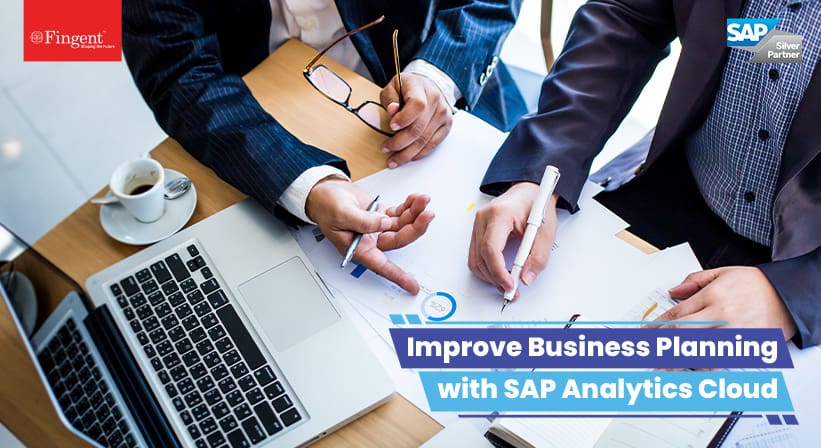Tag: Rise with SAP
The digital landscape is advancing at a rapid pace, and if your business isn’t adapting, it isn’t going to survive. Introducing RISE with SAP—a cloud solution that revolutionizes companies. SAP ranks as the leading global provider of enterprise software solutions. It has consistently helped businesses optimize workflows, boost efficiency, and inspire innovation. But what is prompting companies to step it up? What’s so special about its private cloud variant?
How does it boost scalability and flexibility? And in what ways does it measure up to GROW with SAP?
In this blog, we will explore the reasons why companies are selecting RISE with SAP. We will talk about its key advantages and the prospects of SAP’s cloud offerings to assist you in determining if this suits your business needs.
What is RISE with SAP?
SAP drives digital transformation with more than 280 million cloud users worldwide. They provide services to 99 of the largest 100 companies in the world. RISE with SAP is a comprehensive, subscription-based solution provided by SAP. It helps companies migrate their ERP systems to the cloud. It offers a complete solution comprising SAP S/4HANA Cloud software, cloud infrastructure, and related services. These instruments help improve business operations and promote ongoing innovation. RISE with SAP unites these elements. This simplifies the process significantly, thus transforming companies into intelligent enterprises. These businesses are empowered to adjust rapidly to shifts in the market and emerging technology.
Get the Most From Your Rise With SAP Investment! Let Us Help You Strategize The Best SAP Solution For You
What is RISE with SAP Private Cloud?
RISE with SAP Private Cloud Edition gives companies a secure, custom cloud solution. It is designed to fit specific needs. This enables improved management of IT infrastructure in contrast to the public cloud. It’s perfect for organizations that face complex procedures or strict regulations. It enables users to personalize SAP S/4HANA thoroughly. This fits their unique workflows and connects with third-party applications. RISE with SAP provides a complete solution, not just bits and pieces. It includes:
- SAP S/4HANA Cloud – A robust, next-generation ERP solution. It provides instant data insights and AI automation.
- Cloud Infrastructure – Companies can use SAP’s cloud platform for enhanced flexibility and scalability.
- Business Process Intelligence (BPI) – This toolkit examines existing operations and pinpoints inefficiencies. It then proposes enhancements based on industry best practices.
- SAP Business Network – It links businesses with suppliers, logistics providers, and asset managers for collaboration.
- Technical Migration Services and Tools – They speed up cloud adoption with minimal disruption.
This edition keeps data secure and compliant using dedicated infrastructure. It also supports smooth updates and hybrid cloud integration. The private cloud edition lets businesses innovate and grow at their own speed. They can do this in a safe, separate cloud space.
Why Businesses Choose RISE with SAP Private Cloud
Many convincing factors prompt companies to choose the RISE with SAP Private Cloud:
- Personalization and Adaptability:
The private cloud allows organizations to tailor SAP S/4HANA to work with their industry specifications. They can customize the ERP system to meet their needs. - Improved safety and compliance:
A specialized infrastructure assists companies in safeguarding data. They implement robust security protocols such as encryption and firewalls. It follows GDPR and HIPAA. This is particularly beneficial for sectors that have stringent data governance and compliance regulations. - Simplified Contracts and Operations:
RISE with SAP makes things easier. It offers a single contract encompassing software, infrastructure, and services. This reduces procurement difficulties and simplifies vendor management. - Continuous Innovation:
Organizations benefit from regular updates and the accessibility of new SAP features. This helps them stay competitive and lead in technology. These regular updates let businesses avoid costly IT investments or upgrades. SAP takes care of the innovation cycle.
Supporting Business Scalability and Flexibility
RISE with SAP Private Cloud boosts business scalability and flexibility in key ways:
- Scalable Resources:
With RISE with SAP Private Cloud, companies can swiftly adjust their cloud resources as necessary. During peak periods or seasonal increases, businesses can enhance their computing capabilities, storage, and network bandwidth. This helps maintain top performance. On the other hand, when business is slow, companies can reduce resources. This helps them save money on unused infrastructure. This cost efficiency helps businesses avoid spending too much on hardware. It also lets them manage growth or changing demand easily. - Agile Operations:
RISE with SAP offers powerful tools and services. These enable companies to swiftly adjust to evolving market situations. Businesses can add new features, launch software updates, and enter new markets faster. The private cloud setup lets companies adapt, create, and launch new solutions quickly. This velocity is essential in the current rapid and competitive market. This enables organizations to swiftly adapt to internal and external changes, preventing delays. - Process Enhancement:
RISE with SAP includes integrated analytics and business process intelligence resources. These instruments provide insights that assist companies in refining and enhancing their processes. Businesses create a culture of improvement by enhancing workflows and using actionable data. They focus on boosting performance and growth. This leads to enhanced operational effectiveness and better decision-making across the organization.
What Is the Difference Between ‘Rise with SAP’ and ‘Grow with SAP’?
Sounds like synonyms, don’t they? Yet, there are some key differences between Rise with SAP and Grow with SAP. Here is an overview:
- Target Audience:
- RISE with SAP is made for current SAP customers or big companies that want a flexible cloud solution. These businesses usually have complex processes and diverse needs. They also have a strong IT setup. Thus, they require an adaptable solution that can be tailored to fulfill their particular objectives.
-
- GROW with SAP is intended for small and medium-sized enterprises (SMEs). It offers a quick, standardized ERP solution to help them with digital transformation. SMBs usually have simpler needs and smaller IT budgets. They might also lack in-house skills for deep customization. GROW with SAP is a great choice for them.
- Deployment Options:
- RISE with SAP provides choices for privates as well as public cloud environments. This enables organizations to select the deployment model that fits their needs. Organizations might opt for a private cloud to enhance security, gain more control, and access customization choices. They may opt for a public cloud if they believe it meets their requirements more effectively. It offers cost savings and scalability.
-
- GROW with SAP mainly targets public cloud setups. These come with ready-made best practices. This uniformity helps reduce implementation complexity. It allows SMBs to have a quick, low-maintenance rollout. This is great for companies wanting a quick launch. However, it limits their ability to customize the solution.
- Customization:
- RISE with SAP provides extensive customization options. This renders it perfect for large businesses or those with intricate requirements. This high flexibility lets businesses adjust the system to fit their processes. They can connect with other systems. This helps them create workflows that suit their industry. This degree of personalization, nonetheless, demands considerable time, resources, and skill.
- GROW with SAP boosts efficiency and speed. It offers a consistent approach to ERP. The team limits customization to make the implementation fast and easy. This way, businesses can quickly start using an efficient, ready-made solution. This is great for quick deployment, but it might not work for companies with specific needs.
- Implementation Timeline:
- RISE with SAP often takes longer to implement because of its flexible features. The procedure entails detailed planning, setup, testing, and occasionally reworking current business processes. Organizations can look forward to a detailed implementation phase. This will help make sure the system fits their needs and provides lasting value.
-
- GROW with SAP benefits from a standard ERP solution. This cuts down the time to go live significantly. The pre-set best practices and limited custom options help businesses deploy faster. This indicates they can begin utilizing the system promptly. This is excellent for companies looking to implement an ERP system rapidly.
Understanding these distinctions aids businesses in selecting the most suitable option for their objectives and requirements. Large companies seeking complex solutions and lasting digital change will probably opt for RISE with SAP. Small to mid-sized businesses wanting a fast, standard setup will prefer GROW with SAP.
SAP Business AI: Revolutionizing Enterprise Decisions
Future of SAP Cloud Solutions
- Incorporating New Technologies: SAP is incorporating sophisticated technologies such as AI, ML, and analytics into its cloud offerings. These technologies help businesses in making use of data. They lead to better decisions, reveal trends, and predict outcomes accurately. SAP’s cloud solutions boost efficiency by automating routine tasks. This cuts down on human error and promotes process innovation. This tech integration speeds up business operations. It also helps companies understand their data better. This enhances productivity and boosts customer satisfaction.
- Sustainability Efforts: People are becoming more worried about the environment these days. Thus, SAP is incorporating sustainability into its cloud offerings. They are developing tools that assist businesses in monitoring, assessing, and minimizing their carbon footprint. SAP helps organizations enhance energy efficiency, minimize waste, and create sustainability reports. In this manner, they can synchronize with worldwide sustainability objectives. Also, they meet increasing consumer and regulatory demands for responsible practices.
- Better Collaboration: SAP’s cloud solutions boost teamwork among different business areas and with external partners. SAP’s cloud solutions will improve integration. This will allow smooth communication and data sharing. Data flows smoothly, which accelerates decision-making. It enhances and aids in swiftly addressing market shifts and client requirements. This results in improved synergies and greater innovation.
- Ongoing enhancements and advancements: SAP’s cloud approach emphasizes frequent updates. These updates bring new features, improve capabilities, and upgrade functionalities. This method keeps businesses updated with the latest tech. Thus, they can maintain their advantage in a competitive market. Companies can enhance their functions through AI technologies, improved analytics, and streamlined processes. In this manner, they can implement modifications with minimal disturbance. SAP keeps innovating by regularly updating its cloud solutions. This helps them stay current and ready for the future. It provides them with the capacity to adapt to emerging technologies, shifts in the industry, and changing customer demands.
SAP’s cloud strategy revolves around four key areas: advanced technology, sustainability, teamwork, and ongoing innovation. These factors assist companies in enhancing efficiency. They can thus stay competitive and promote global sustainability, developing a digital environment that adjusts to evolving market needs.
SAP with Fingent
RISE with SAP, especially the Private Cloud edition, provides a strong framework. It helps businesses modernize operations and embrace digital transformation. SAP offers a flexible and secure cloud solution. This helps organizations grow efficiently. They can quickly adapt to market changes and encourage continuous innovation.
Fingent, a certified SAP partner, offers custom SAP solutions made for your business needs. We know how to make your move to the cloud easy. This helps your organization use all of SAP’s features. Using our services will ensure that you get the best deals and opportunities of growth for your business.
Stay up to date on what's new

Featured Blogs
Stay up to date on
what's new



Talk To Our Experts
In 2025, startups will disrupt sectors. They establish trends and redefine the rules. But here’s the catch: even pioneers require a strong strategy. And that’s where technology plays a role. SAP for Startups, an innovative suite that was once limited to large companies, is now transformed! It is set to support the aspirations of new enterprises.
Let’s explore the development of SAP S/4HANA for Startups and understand why it has become a powerful tool for startups seeking to lead the market.
What is SAP, and Why is It Important for Startups?
Think of SAP as the ultimate multitool for your business—like a Swiss Army knife with turbo boosters. SAP is the gold standard of ERP systems.
SAP is about pulling your key operations—finance, sales, supply chain, HR—into one big, happy digital family. No more juggling a dozen tools that barely talk to each other. SAP makes everything work together like a well-rehearsed orchestra.
This is important because startups frequently manage numerous competing priorities simultaneously. Imagine scaling your business while keeping track of finances on one tool, managing inventory on another, and relying on sticky notes for HR reminders.
Studies show that the primary motivations for companies to adopt ERP solutions are to boost efficiency (35%) and secure cost benefits (29%) – essential elements for a startup aiming to establish its presence in the market.
For many years, SAP was the exclusive domain of the corporate elite—something that only Fortune 500 firms could pay for. However, due to programs such as “GROW with SAP,” startups now have the same resources to structure, expand, and excel. It’s no longer about size; it’s about ambition, and SAP levels the playing field for anyone with big dreams and a smart plan.
Power Up Your Startup To Drive Success Discover Unique Opportunities with Modern SAP Solutions
How SAP for Startups Helps Businesses
Did you know? The global ERP market is expected to grow at a CAGR of 9.8% from 2022 to 2030. This is clear evidence that businesses are now recognizing the many benefits that SAP brings to the table. Here are some of the benefits:
- Integrated Operations: No more juggling a dozen apps. SAP ties all your processes into a cohesive system, saving you time and headaches.
- Scalability: Got big plans? SAP scales with you, so you’re not constantly switching systems as you grow.
- Data-Driven Decisions: Access real-time data to make smarter, faster business moves. No more flying blind.
Key Benefits of SAP for Startups
SAP helps you go deeper into your operations and get a holistic view of your businesses so all components make sense individually and come together beautifully. Here’s how it achieves that:
Comprehensive Business Management
- Integration: Imagine this—your finance, sales, HR, and supply chain all communicating within a single cohesive system. That’s the enchantment of SAP.
- Efficiency: Optimized procedures lead to reduced delays and less resource wastage. For startups with limited budgets, this is a revolutionary development.
Analytics in Real-Time
- Instant Understanding: Picture having precise knowledge of your business’s performance whenever you want. Real-time analysis allows you to respond to alterations before they escalate into issues.
- Predictive Analysis: Curious about what’s ahead? SAP’s data tools assist you in identifying trends and preparing for the future rather than solely focusing on the present.
Cost Efficiency
- Cloud Solutions: No need for expensive servers or IT teams. SAP’s cloud-based systems cut upfront costs and simplify maintenance.
- Subscription Models: Pay-as-you-grow pricing means SAP fits within startup budgets.
Enhanced Collaboration
- Centralized Data Access: All team members can retrieve the same current information, making collaboration more efficient and rapid.
- Unified Communication Tools: Wave farewell to misunderstandings and welcome improved collaboration.
Scalability for Future Preparedness
- Modular Structure: Add new features as your business grows without interfering with the system.
- Uninterrupted Updates: Regular updates consistently inform you about the latest technology developments.
Understanding SAP S/4HANA for Emerging Enterprises
Consider SAP S/4HANA as an advanced ERP system enhanced to the utmost potential. It’s founded on an in-memory database, which is technical jargon for “extremely rapid data handling.”
This is what it signifies for startups:
- Streamlined User Experience: The SAP Fiori interface is crafted to be user-friendly, enabling your team to adapt rapidly.
- Instant Data Processing: Eliminate the delays of overnight updates—data is processed immediately, enabling you to make quick decisions.
- Cloud Deployment: Eliminates the stress of managing servers. The cloud configuration is adaptable, safe, and simple to oversee.
How SAP Helps Startups Across Business Functions
SAP isn’t just a tool—it’s your business’s secret weapon, wingman, and productivity guru all rolled into one. We invite you to take a look at how it manages different functions with precision:
Finance
- Automation: SAP can tackle those mundane number-crunching tasks within no time. This way, your finance team can focus on the big picture. Think development strategy, not a budget sheet.
- Compliance: Keeping up with regulations sometimes feels like playing an obstacle course. SAP always has your back. It provides you with real-time, accurate reporting that helps you stay on the right side of the law. No fines, no stress.
Read more: SAP in Finance Transformation
Sales and Marketing
- Customer Insights: You don’t have to analyze exhaustively to know what your customer wants. SAP dives into their buying habits with a data-driven magnifying glass. The result is tailored marketing strategies that hit the sweet spot.
- Sales Tracking: SAP enables you to track your sales journey by showing where you’re headed, alerting you to detours, and keeping you on track to close those deals faster than ever.
Supply Chain Management
- Inventory Control: Too much stock can mean you are losing profits. You will lose much-needed sales if you do not have enough of it. SAP ensures your inventory is always perfect—not too much, not too little, but just right.
Read more: Top 5 Ways SAP S/4HANA Can Improve Your Supply Chain Management
Human Resources
- Talent Management: Hiring, onboarding, performance reviews – need not be a hassle anymore. SAP turns the HR chaos into a streamlined process so you can focus on building a dream team instead of drowning in paperwork.
- Employee Self-Service: Your team deserves some autonomy. SAP’s self-service tools allow them to access pay stubs, apply for leave, or update personal details without bothering HR. It’s empowerment in action.
Cost Benefit Analysis of SAP S/4HANA Migration
SAP for Startups: Case Studies and Success Stories
Case Study 1: SAP for Faster & Intelligent Decisions
Team Liquid—an ambitious esports company—needed an edge to compete at the highest levels. They turned to SAP Business AI, which analyzed match data faster than you can say “game on.”
The result? Smarter strategies, faster decisions, and a clear path to victory. SAP didn’t just help them play; it helped them dominate.
Case Study 2: Enhanced Data Utilization with SAP
On the beverage front, CONA Services supports major North American Coca-Cola bottlers. By implementing SAP solutions, they streamlined operations, ensuring efficient distribution and customer satisfaction. This integration allowed them to manage vast amounts of data seamlessly, enhancing their service delivery.
Why Startups Should Consider SAP Early On
Here’s why it pays to jump on the SAP for Startups train early:
- Foundation for Growth: It helps you get your processes in order now, so you’re not scrambling as you scale.
- Investor Confidence: A solid ERP system shows investors you mean business.
- Competitive Edge: It helps you leapfrog your competitors with tools built for the big leagues.
Getting Started with SAP for Startups
Ready to dive in? Here’s your roadmap:
- Assess Business Needs: Determine where automation and integration can impact most.
- Explore SAP Offerings: Check out solutions like ‘GROW with SAP for Scaleups’ to find your perfect match.
- Engage Implementation Partners: Work with certified SAP pros to get up and running smoothly.
- Invest in Training: Equip your team with the skills they need to make the most of the system.
Challenges Startups May Face with SAP Implementation
Remember, implementing SAP isn’t all unicorns and glitter! There are a few speed bumps you should be aware of:
- Initial Investment: The pricing is startup-friendly, so there is no doubt about it. However, it’s not pocket change.
- Change Management: Swapping systems is more than tech. It’s about getting people on board. Change can feel like pulling teeth, but the right change management techniques can work wonders.
- Customization Needs: Every startup is unique, and making SAP “fit like a glove” might require some tailoring. However, the benefits are worth the effort.
Discover How SAP Can Enhance Your Operational Capabilities
SAP S/4HANA for Startups vs. Other ERP Solutions
When choosing the right ERP, think of how you would buy your perfect pair of sneakers. It should feel right to run well while keeping up with your pace. So, let’s lace up and compare SAP to other ERPs:
- Flexibility and Customization: SAP allows you to tweak things but keeps them structured. Other ERPs might let you go wild with customization, but that’s a one-way ticket to headaches.
- User Experience: The SAP Fiori interface is easy to use and easy to navigate. Compared to older ERPs, which feel more like trying to read a map in the dark, it is a pleasure to use SAP Fiori.
- Deployment Options: SAP lets you choose whether to deploy in the cloud or on-premise. It’s like a menu at a great restaurant—you choose what suits your appetite (and budget).
- Scalability: Start small, dream big. SAP grows with you, whether you’re a small team of 5 or a booming business with 500 employees.
- Industry Suitability: SAP might be famous for powering big corporations, but it’s just as ready to roll up its sleeves for ambitious startups. Other ERPs might be great for smaller operations but lack the horsepower you’ll need to scale.
Soar to New Heights with SAP S/4HANA for Startups
SAP S/4HANA for Startups isn’t just another tool in the tech tool set. Essentially, it is the propellent your business needs to soar to new heights. It can tackle growth, competition, and chaos like a total pro. This is 2025 and are you ready now to leap? Don’t just dream, remain dormant, or act big and dominate?
So, what’s the holdup? Let SAP turn your hustle into a headline. Contact us now!
Stay up to date on what's new

Featured Blogs
Stay up to date on
what's new



Talk To Our Experts
Regardless of its size, every business needs to work seamlessly with perfect efficiency to stand out and be noticed. Among the many different essentialities that course through the veins of a business, data allocation and decision-making are two important ones. Although it may seem like just a part of the nitty gritty, it plays a paramount role.
In this article, we will understand what data allocation is all about, and we will familiarise ourselves with how SAP Analytics Cloud can help with data allocation.
Understanding Data Allocation
Before we move any further, let us first thoroughly understand data allocation. Data Allocation is essentially an intelligent distribution system that places your data fragments into sets to improve overall database performance. It also drastically reduces the costs of transaction processing and enables owners to distribute revenue, expense, and statistical amounts across multiple business units, departments, and even other businesses.
Traditional data systems such as data warehouses and relational databases have existed for nearly 30 years. Although “old is gold,” it does not apply in this case. These traditional, or quite frankly outdated, systems have many challenges that cannot always be overlooked. A few of these key challenges faced by traditional data allocation methods that lead to the creation of modern systems are –
- Large data is too big for traditional storage
- Data can be of higher complexity
- Data quality tends to drop during allocation
There are many reasons why data allocation is beneficial to a business in terms of its performance and decision-making; listed below are some of those benefits:
- Employees’ relief – data allocation removes a lot of unnecessary strain from accountants or employees as it eradicates the mundane nature of this task.
- Client satisfaction – An optimal resource allocation system identifies the most appropriate team with complementing skills that cross-section to deliver perfect results for the project.
- Increased decision-making accuracy – With the correct data and analytics tools, businesses can make accurate and appropriate decisions in real time, ultimately leading to an increase in accuracy and efficiency.
- Boosts risk management and mitigation – By allocating data, businesses have a better insight into any potential risks and can take proactive measures to mitigate them deftly. This can help your business avoid costly mistakes and prepare you for the impact of unforeseen attacks.
Introduction To SAP Analytics Cloud
SAP, short for Systems, Applications, and Products, is a leading software company founded in 1972. It is essentially a software supplier, and ERP software systems are created and supervised by SAP. SAP Analytics Cloud was released in 2015 and is a cloud product that offers services (SaaS) for business intelligence (BI), planning, and predictive analytics. Its united and highly secure cloud maximizes data-driven decision-making for businesses.
The three fundamental components of SAP are:
- Business Planning – for data collection and analysis
- Business Intelligence – for reporting, data discovery, and visualization
- Predictive Analytics – for future-proofing and compliance
The SAP Analytics Cloud comes with several benefits, including enterprise planning tools and tools to align your company’s expenses and cost strategies. These are helpful in fields like HR, Sales, IT, and Marketing.
The SAP Analytics Cloud’s allocations feature is a widely famous and useful tool for businesses to analyze and designate values on objects on the driver. Regardless of whether you are a seasoned SAP Analytics Cloud user or a novice to the platform, the cloud has a solution to almost any problem a user may face. With its seamless integration, enticing design, and advanced capabilities, this Cloud offers a compactable solution for large and small businesses with customizable dashboards, enhanced reporting features, and easy-to-use tools.
Read more: SAP Customer Experience: Creating Seamless Omni-Channel Experiences.
Optimizing Data Allocation With SAP Analytics Cloud
Optimization of data is the process of extracting, analyzing, and storing data for maximum efficiency. There are innumerable optimization tools on the internet, and although they each have their own unique features, SAP Analytics Cloud is known to be the best. With this solution, there is a wide array of optimization under-structures. A few of them are Browser/Client Optimization, Analytical Application Optimization, Story Optimization, Planning and Data Action Optimization, Network Optimization, and Backend Optimization.
SAP Analytics Cloud fulfills the needs of data visualization, budget planning, and predictive analytics perfectly. SAP developed it as an unabridged SaaS-based product that would have no shortcomings. It holds up this reputation by covering a wide range of needs, from data visualization, budget planning, and predictive analytics to automated data allocation, collaborative planning and budgeting, centralized data repository, and real-time integration.
Use Case: Successful Implementation Of SAP Analytics Cloud For Data Allocation
It must already be clear by now that SAP Analytics Cloud is a brilliant tool that can benefit any organization that uses it. Digressing from it will weaken your business’s reputation and functioning. This cloud system is put to extensive use in many sectors of society; three of the major sectors are:
- Financial Sector – It is used for large-scale budget streamlining and forecasting analytics processes.
- Manufacturing Industry – In this industry, the cloud allocates resources and optimizes production planning.
- Retail Sector – The retail sector has recently tapped into the potential of SAP Analytics, and they enjoy it completely by using it for managing inventory and demand chain predictions.
Best Practices For Implementing SAP
Similar to the implementation processes of many advanced technologies, even SAP Analytics Cloud has a set pattern to follow for maximum efficiency.
1. Define Clear Data Allocation Objectives And KPIs
Starting with a crystal clear vision always helps. Keep your Business Intelligence and Business planning locked and loaded before the implementation begins.
2. Collaborative Planning And Involving Stakeholders
This step is usually overlooked, but that would be a mistake. It is imperative to keep your business stakeholders in the loop for any implementation as it will cost the organization money, and stakeholders need to be able to organize a budget for it. Collaborative planning within the company will also boost the process and make it more secure.
3. Ensuring Data Accuracy And Integrity
This can be achieved through proper validation and cleansing. Running through multiple models before the final implementation is vital. Business data is highly confidential; therefore, ensuring its accurate integration and clear integrity is a top priority.
4. Continuous Monitoring And Optimization Of Data Allocation Processes
The last practice would be to complete maintenance after implementation. Aftercare is important. Keep an active eye on the cloud’s allocation processes and optimization habits.
Future Trends And Innovations In SAP Analytics Cloud
The SaaS service is an ever-evolving and continuously progressing service with new features consistently popping up. The future of SAP Analytics Cloud is bright, and investing in it at the earliest is a great way to be a part of this future. Three of the biggest trends and innovations in SAP Analytics Cloud are:
1. Integration With Emerging Technologies
The involvement of any form of advanced emerging technology already promises a skyrocketing rate of progress. These technologies will enable SAP Analytics Cloud with real-time integration and processing, among many other things.
2. Embedded Analytics And Real-Time Insights For Faster Decision Making
Alongside data allocation, SAP Analytics Cloud thrives in efficient decision-making. With its embedded analytics and consistent real-time insights, the whole daunting decision-making process will be overtaken by this cloud.
3. Predictive Analytics For Proactive Resource Allocation And Forecasting
Lastly, this cloud service is bound to enhance its predictive analytics for more appropriate resource allocation and demand predictions. This is probably the most impactful trend that can emerge in SAP Analytics Cloud as it can make your business future-proof and ready.
Read more: A Simple Guide To Handling Common SAP Errors & Troubleshoots.
How Fingent Can Help
Fingent provides certified experts for a client-centered service with transparency and good communication. These experts utilize the latest and fast-emerging advanced technology to make your SAP S/4HANA implementation process easy and flawless. We assist our clients through every step of the implementation process and even provide excellent post-implementation support by monitoring performance, addressing user feedback, and providing any necessary fixes.
Give us a call, and let’s talk about how we can make SAP Analytics Cloud work for you.
Stay up to date on what's new

Featured Blogs
Stay up to date on
what's new



Talk To Our Experts
Today, technology unlocks the value of time, allowing us to easily juggle multiple tasks and accomplish much more in less time. For some time now, SAP has become the backbone of efficient business operations. It has helped many businesses streamline their operations and scale their business to never before imagined heights.
Have you implemented SAP yet? If you have, then you must see firsthand how amazing it is! In this blog, we will help you maintain that awesomeness by giving you some great tips on managing and troubleshooting common SAP errors and issues.
Why SAP Is No Longer An Option But A Necessity
To manage current processes, many businesses still use a wide array of legacy software programs and possibly cloud apps to handle different procedures.
Did you know: Enterprises add 1,061 applications on average to their ecosystem. – 2023 connectivity Benchmark Report by Mulesoft Research.
In many organizations, it is common for separate departments to purchase and develop their own software solutions, operating independently of one another. This can lead to the use of multiple software programs within a department, which often lack the ability to integrate with each other.
A 2023 connectivity Benchmark Report by Mulesoft Research shows that only 29% of the surveyed businesses’ applications are properly integrated.
As a result, businesses may struggle to create a unified ecosystem that meets their current needs. To address this, audit your current toolkit and consider implementing a comprehensive ERP solution that can integrate various business operations. SAP solutions offer the ability to integrate these modular apps and create a more cohesive business system. By using a unified approach, businesses can improve their overall operations and drive growth.
The report by Mulesoft Research further mentioned that only 36% of enterprises consider the lack of integration between siloed apps the biggest challenge to digital transformation. Now if you aren’t one of them and have already implemented SAP, that is commendable indeed! –
However, the SAP system can be quite intricate. Given that, issues and errors may arise due to various factors.
Read more: Driving Business Modernization with SAP!
Suggestions And Tips to Manage and Troubleshoot SAP Implementation Issues
Here are some suggestions for common SAP errors and issues along with tips to manage and troubleshoot those issues effectively.
Issue #1- Slow Performance
Various aspects affect performance. These include network issues, database problems, or system overload. SAP performance issues, if ignored, can cause serious problems. To troubleshoot and manage this try the following steps:
- Identify the source: Identify the component or area that is responsible for the slowness. You can do this by keeping a tab on SAP performance metrics like response times, resource usage, and so on.
- Analyze logs and traces: Use tools provided by SAP to analyze logs and traces.
- Monitor hardware and network components: Monitoring servers, storage devices, and network components can help ensure the hardware is adequately configured, updated, and optimized.
- Check system performance: Check system performance periodically to identify trends and patterns.
- Optimize database: Check for memory leaks and increase database cache if necessary. Perform regular maintenance tasks like defragmentation and indexing.
Issue #2 – Authorization
Authorization problems may arise if SAP users lack the necessary access to certain transactions or functions. Here are some steps you can take to address authorization issues:
- Check who has what authorization: Confirm that users have the appropriate authorizations for the pertinent transactions and functions. The specified user needs a specific authorization object. Use the SE37 transaction or SE80 in test mode. The result table is very compact and easy to understand for authorization experts.
To help solve authorization problems, you can ask yourself:
- What data did the user access to avail which function?
- What was the reaction of the system and how should it have reacted?
- How is the authorization check set up?
- Verify if the roles and profiles match: Ensure user roles and profiles are correctly assigned.
- Use the right tools: Utilize the authorization trace tool to identify any authorization problems.
Issue #3 – Data Inconsistencies
Data inconsistency problems can occur when data is incorrectly entered or updated in SAP. These issues fall into one or more categories such as unavailable data, internal inconsistency, inconsistent page, and inconsistent page set. To identify and troubleshoot data inconsistencies, try the following steps:
- Identify: Identify the database and the table space that contain inconsistent data.
- Prevent escalation of the problem: Limit access to the data before an attempt is made to resolve the inconsistency. Doing so prevents subsequent updates to the inconsistent data and thus prevents the problem from escalating.
- Verify data: Verify if the data entered and updated is correct in SAP.
- Search the data: Locate missing or duplicate data.
- Use the right tools: Use the data consistency check tool to identify data inconsistencies.
Issue #4 – ABAP Programming Errors
ABAP programming errors can have many causes and can interrupt the program. The most common reasons for these errors are non-handled exceptions, or that a handleable exception was not handled, a non-handleable exception was raised, an exit message was sent, or an assertion failed. Here is what you can do to troubleshoot the issue:
- Analyze the error message: Read the error message carefully to understand the nature of the problem. Look for keywords or specific error codes that can provide insights into the issue.
- Review the code: Examine the ABAP code where the error occurred. Pay attention to the line number mentioned in the error message. Check for syntax errors, missing or incorrect statements, or any potential logical issues.
- Debug the code: Use the ABAP debugger to step through the code and identify the exact point where the error occurs. Set breakpoints in the code to stop execution at specific lines and observe variable values to pinpoint the problem.
- Analyze data and variables: Evaluate the data and variables used in the code. Ensure they contain the expected values and are correctly assigned. Use data inspectors, watchpoints, or variable analysis tools to monitor their values during runtime.
- Check system logs: Review system logs, such as the ABAP runtime error log (ST22 transaction), to gather additional information about the error. Look for any relevant entries that can provide clues about the root cause.
- Apply software patches and updates: Ensure that your SAP system is up-to-date with the latest patches and updates. Some errors might be resolved by applying the relevant software fixes provided by SAP.
Issue #5 – Integration Issues
Integration issues occur when there are issues with data exchange between SAP and other systems. To troubleshoot integration issues, try the following steps:
- Identify the scope and symptoms: Clearly define the integration problem you are facing and identify the specific symptoms. For example, determine if it’s a data transfer issue, communication problem, or functional discrepancy.
- Review integration configurations: Verify the integration settings and configurations in both the sending and receiving systems. Check the integration points, interfaces, message types, mappings, and adapters to ensure they are correctly set up.
- Check system connectivity: Validate the connectivity between the systems involved in the integration. Ensure that network connections, firewalls, and communication channels are properly configured and accessible.
- Analyze error messages and logs: Examine error messages, log files, and monitoring tools specific to the integration scenario. SAP provides various tools like SAP PI/PO monitoring, SAP AIF, or SAP CPI for monitoring and error analysis. Analyze the messages and logs to identify any error codes, timestamps, or specific details that can help pinpoint the issue.
- Collaborate with integration partners: Engage with the stakeholders involved in the integration, such as functional consultants, technical teams, or external partners. Collaborate to understand their system configurations, share information, and jointly troubleshoot the issue.
Read more: Top Business Benefits to Gain with Fingent’s SAP AMS Services!
How Can Fingent Help
Automating the monitoring and optimization of SAP performance can significantly enhance your enterprise operations. It is a positive step towards maximizing productivity and efficiency. As a trusted industry leader, Fingent can assist you in optimizing your SAP system and other relevant tools to ensure they function seamlessly within your enterprise.
To avoid costly performance and security issues associated with SAP systems, it is advisable to consult our experienced SAP experts. At Fingent, we are proficient in tailoring SAP solutions to meet the unique need of your enterprise. Our team is equipped with global expertise in implementing SAP solutions across various industries and business sizes.
Contact us today to explore your SAP options and benefit from a seamless implementation that aligns with your enterprise requirements.
Stay up to date on what's new

Featured Blogs
Stay up to date on
what's new



Talk To Our Experts
Are you a business owner who is in a quandary about migrating your business to SAP S/4HANA? Do you do it now, or do you wait? Here’s some help!
Most business owners are moving toward SAP S/4HANA at their own pace. Most businesses put away migration due to the lack of urgency. For one thing, they feel that the discontinuation deadline of support ERP support is four years away (2027). Not all agree, though.
24% of businesses are already using SAP S/4HANA.
If this isn’t reason enough, a business should move to SAP S/4HANA to make the project worthwhile on all fronts: SAP S/4HANA is a prerequisite for completing your digital transformation. Without that transformation, you will be left behind your competitors. Worse yet, you will be behind where your users expect and need you to be.
SAP S/4HANA is not just a technical upgrade, it is a business transformation. So, you should not be asking, do it now or wait. Instead, remember the current scenario: it is now or never!
Takeaway: the longer you wait to migrate to SAP S/4HANA, the farther you will fall behind your competitors.
Read more: Strategizing a successful SAP S/4HANA Migration for your business
Top 10 Reasons Why You Must Migrate Now
The reasons for migration are compelling because the benefits are significant. With S/4HANA, companies can focus on growth and expansion without worrying about the technical aspects of integrating various IT systems.
The benefits of S/4HANA are countless, and it is time for your business to unlock its full potential. Join the league of agile and adaptable businesses today by incorporating S/4HANA into your business model.
Did you know: Increased revenue from functionality enabled by SAP S4HANA resulted in a net profit of 25.2 million?
1. Better Integration and An Intuitive User Experience
S/4HANA comes with a sleek and user-friendly interface that makes it easy for businesses to design custom apps that work seamlessly across various devices. For instance, a company can create separate apps for sales inquiry, order overview, and sales fulfillment and then grant access to these apps based on the user’s role.
S/4HANA makes it simple to deploy one or many apps across different departments and functions, including sales, human resources, finance, and much more. With better integrations and an intuitive experience, S/4HANA is a smart choice for organizations looking to streamline their operations and boost productivity.
Did you know: Customer retention valued at 8.4 million was made possible due to the capabilities enabled by SAP S/4HANA?
2. Real-Time Analytics
One of any business’s top priorities is access to real-time data. Real-time data can help provide actionable insights on everything – from user behavior and user interactions to business intelligence.
Using a mechanism called a virtual data model, SAP S/4HANA can transform on-the-fly data optimized for transactional purposes into an analytics-ready structure. This solution can benefit users in business processes as they need valuable and relevant insights to help them make the right data-driven decisions on the fly.
SAP S/4HANA Embedded Analytics offers users a fantastic advantage by offering a plethora of preconfigured Business Content in the form of KPIs, analytical reports, predictive and planning scenarios, dashboards, and multidimensional reports that are like advanced pivot tables. This wealth of resources makes it incredibly user-friendly by providing ready-to-use solutions that cater to specific business requirements.
Did you know: Increased revenue from functionality enabled by SAP S4HANA resulted in a net profit of 25.2 million?
3. Enhanced Mobility
S/4HANA is the key to agility and flexibility in the business world. With its easy-to-use interface and flexible deployment options, the system allows companies to seamlessly update their business processes. Add a new sales channel, acquire a new company, or undergo a merger – S/4HANA can handle it all.
Let’s take the example of a company that has acquired another company that uses SAP and non-SAP IT systems. In the past, aggregating data, indexing, and integrating it would have been a daunting task. However, with S/4HANA, the integration process has become seamless and effortless. The system provides an option to bring the system into the SAP cloud without needing to integrate them. Businesses can leverage applications like Simple Finance to aggregate data from all of their acquisitions and subsidiaries without any hassle.
Did you know: Reduced run times are valued at over 2.1 million?
4. Simplified Landscape
SAP S/4HANA has revolutionized the business world by offering a simplified landscape. Businesses can now reduce complexity and streamline operations, thanks to this innovative solution. With SAP S/4HANA, companies can manage their IT infrastructure with ease, freeing up resources to focus on core business activities. From analytics to supply chain management, SAP S/4HANA provides all the support a business needs in a simple, intuitive package.
Furthermore, the system is cloud-ready, meaning that businesses can have access to the latest technologies and innovations without having to continuously upgrade their systems. SAP S/4HANA offers rich functionality and data analytics capabilities, providing businesses with real-time access to critical information and insights.
With a simplified landscape, companies can focus on their business objectives and drive growth, without worrying about the complexity of their IT infrastructure. In conclusion, SAP S/4HANA is the future of business systems. A simplified landscape is the first step toward unlocking the full value of the system and is becoming increasingly necessary. SAP S/4HANA is the perfect solution for businesses seeking a simplified IT environment that is scalable, intuitive, and functional.
Did you know: Increased productivity of IT organization employees is worth $442,971?
5. Advanced Automation
With S/4HANA, businesses can say goodbye to boring, repetitive tasks thanks to the Robotic Process Automation solutions that automate these mundane tasks. This leaves employees with more time to work on important tasks that require special attention. To make things even better, there are over 150 RPA bots available to use with S/4HANA. The integration of AI and ML technologies can provide intelligent insights into data collected from automation, taking things to the next level.
6. Better Data Management
If you run a business, you know how important database management is. Well, with SAP, you can take a deep breath and relax. They got you covered with a bunch of solutions made to make your IT environment even more manageable.
For example, with SAP HANA database administration, all your SAP ERP data is under lock and key and constantly being checked for optimization. You will never have to worry about it being unavailable.
7. Improved Integration
Preparing financial reports for a multinational company with multiple subsidiaries is not an easy job. It is tedious to connect with different groups, collect data and prepare reports. However, with S/4HANA you can easily connect with other people and groups and close books faster. Improved integration enables you to monitor, access, and analyze data from different groups.
Did you know: Accelerated cash flow managing customer orders valued at $439,675?
8. Greater Scalability
As a business grows, it’s crucial to ensure that data storage, access, and processing capabilities are able to scale accordingly. Fortunately, SAP S/4HANA offers a valuable advantage in this area with its ability to easily scale based on concurrent users and associated data volume across various network environments. This means that businesses are able to expand their data models without the concern of decreased performance. With SAP S/4HANA data growth will not impede a business’s ability to keep up with demand.
Did you know: Simplified accounting accelerated collection worth 1.1 million?
9. Enhanced Security
SAP S/4HANA is known for its exceptional data and application security, making it a top choice for many organizations. Additionally, the platform offers secure setups and other benefits. Moreover, privacy features enable compliance with regulatory and compliance requirements.
10. Future-proof your business
SAP S/4HANA is a cutting-edge platform created to cater to contemporary businesses’ and future demands. Its state-of-the-art features will enable businesses to stay adaptable and keep up with the ever-changing business environment, ensuring they stay competitive.
Read more: SAP ECC vs SAP S/4HANA – What should be the next move for your business?
How Can Fingent Help
From vision to design and delivery to maintenance, Fingent can help bring end-to-end expertise to your business’s digital transformation challenge with SAP S/4HANA. Our team can assist in transforming your strategic goals into a digital framework that streamlines your procedures and simultaneously triggers future innovation.
We offer a range of services, from implementing new systems to converting and consolidating existing SAP Business Suite systems. Our expertise in strategy and delivery enables us to join your journey at any stage, producing a sustainable platform that facilitates the growth of your business. Reach out to us today and let’s get started on this amazing transformation.
Stay up to date on what's new

Featured Blogs
Stay up to date on
what's new



Talk To Our Experts
SAP ECC and SAP S/4HANA are two key ERP software offerings from SAP that allow enterprises to simplify the management of business processes, enable effective data processing, and facilitate streamlined information flow across organizations. Though SAP ECC is the most commonly used ERP software, things will change as SAP ends its support for ECC 6.0 in 2027. As ECC is reaching the end of the line, the most practical way for businesses to benefit from SAP’s exceptional solutions is to migrate to SAP S/4HANA.
Like ECC, S/4HANA too offers solutions to enhance business process efficiency and the customer experience in areas like finance, inventory and asset management, sales, marketing, HR, logistics and supply chain, and product development, but in an incredible and unprecedented manner.
Before moving to the world’s most intelligent and modern ERP, it’s important to understand how SAP S/4HANA is different from its predecessor, SAP ECC.
What is SAP ECC?
SAP ECC is short for SAP ERP Central Component, the previous generation of SAP’s enterprise resource planning (ERP) software. Due to its modular design, SAP ECC is highly customizable and can be configured to suit the different needs of a business, such as finance, logistics, warehousing, human resources, product planning, customer service, and so on. The most striking feature of ECC is its ability to work with third-party or customized applications. For example, ECC can operate on a third-party database such as IBM DB2 or Oracle database and can work with customized applications like business messaging apps.
Due to its interaction with different components in the landscape, ECC is flexible, which also brings in more complexities. This is because a change in one component can affect how other parts function in the ecosystem. So, rolling out any change, such as customization, upgrades, add-ons, or enhancements, demands a thorough and careful testing of the landscape to ensure that your important business functions remain undisrupted.
With SAP phasing out ECC, users are left with only one alternative: moving to S/4HANA.
Read more: SAP for Business: 9 Ways to Maximize Business Performance
What is SAP S/4HANA?
SAP S/4HANA is the world’s most intelligent, complete, and modular cloud ERP software that simplifies your business landscape. It facilitates accelerated deployment by lowering costs with a standardized core and brings agility through an open, modular, scalable, and innovative platform. S/4HANA service management integrates crucial functions from various lines of businesses and industries and incorporates parts of SAP Business Suite Products.
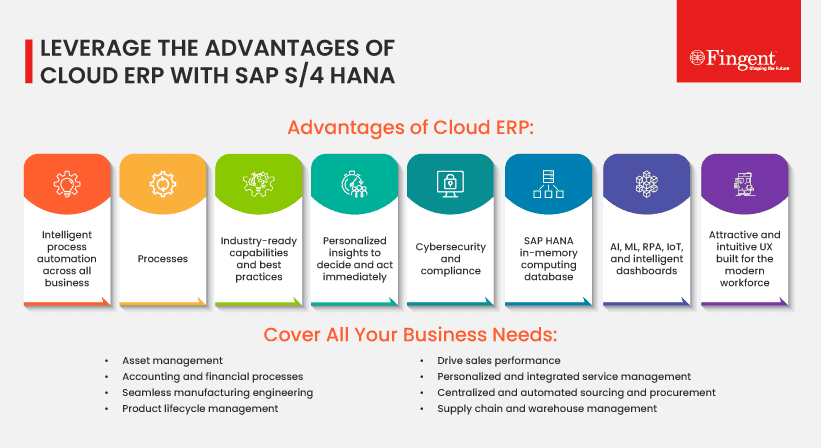
What is the difference between SAP ECC and SAP S/4HANA?
Though ECC provides modules covering a full range of industrial and enterprise applications that can be run on a database of the user’s choice, the legacy ERP system fails to leverage the intelligent technologies needed to be competitive today. S/4HANA differs from ECC in many aspects:
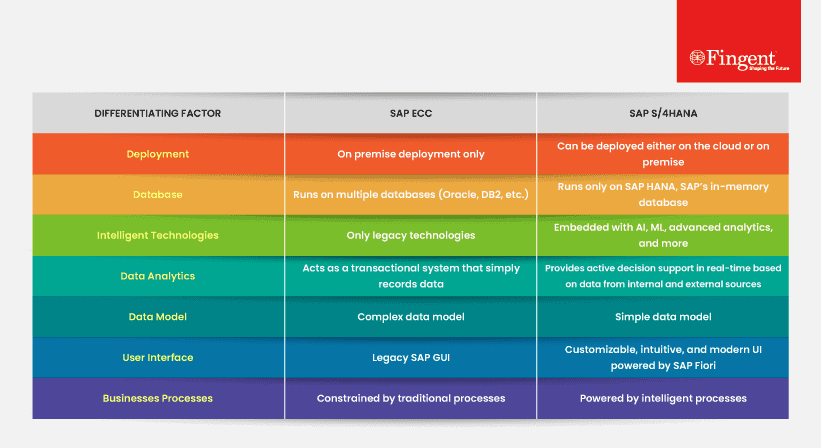
Why Move to SAP S/4HANA Now?
Making decisions based on accurate and appropriate data is critical to gain a competitive advantage in today’s dynamic world. With SAP S/4HANA, organizations can use data, people, and enterprise assets in an aggregated manner that best suits their business. Moving to SAP S/4HANA offers you the following advantages:
1. Simplified Technical and Data Architecture
Businesses are attracted to SAP S/4 HANA due to its simplified data table structure and access. SAP HANA’s in-memory computing platform provides a database that operates way faster than the database options used in ECC or any traditional OLTP system. In SAP S/4HANA, there is no need to separate OLTP and OLAP applications into different databases or applications, as a single HANA database can handle both types of operations effectively. The traditional OLTP systems are generally slow at reading and analyzing data that gets updated while processing transactions. SAP S/4HANA offers restructured data models, allowing customers to access data reports faster.
2. Access to Innovative Technologies
Introducing a fresh bulk of innovative technologies will help you address all the upcoming business requirements. Built-in machine learning is an outstanding capability of S/4HANA that automates key business processes across your organization. Real-time insights, predictive BI, and automation free your employees from mind-numbing work and help them focus on value-adding tasks. Access to innovative trend technologies will keep you one step ahead of your competitors.
3. Invest in Your Growth Strategy
You can build an appropriate strategy with fully-automated data if your business is growing and venturing into new markets. Remember that your current SAP ERP has a shorter shelf-life. Failing to catch up with the latest trends and developments will be costly. Investing in an intelligent ERP system is a business imperative, for it will support and complement your growth strategy and increase your speed-to-market.
4. Consistent User Experience Across All Devices
SAP Fiori – the design system that powers the user experience of SAP S/4HANA – defines how the new business value of S/4HANA is delivered to users. The Fiori design system delivers a modern user experience that works on various devices (desktop, laptop, tablet, smartphone) to ensure faster response times and better performance. Digital age user experience, end-to-end real-time analytics, new business processes (such as Group Reporting, Central Procurement, and Predictive MRP), and intelligent automation (such as Situation Handling, AI/ ML proposals, RPA) scenarios are the key value drivers for using SAP Fiori in SAP S/4HANA. Above anything, you need SAP Fiori to configure, adapt and extend SAP S/4HANA.
5. Avert The Risk of Falling Behind
SAP is no longer investing in ECC as the legacy ERP is reaching its end of life in 2027. On the other hand, SAP S/4HANA incorporates many innovative features through its dynamic quarterly releases that make its core even more intelligent. Several companies around the globe have already started their migration, and some are working fervently on their migration plans. Considering the predicted shortage of skilled SAP consultants and the rising cost of quality consulting services, it’s vital to bridge the gap and avert the risk of falling behind by acting now when there are available resources. Working with a trusted and certified SAP specialist, you can keep your project time, budget, and risk to the minimum. Also, if you have any plans to renew your hardware or hosting solutions, the SAP S/4HANA migration process and hardware purchase should happen simultaneously to avoid any non-compliance.
How Fingent Helps You Accomplish a Seamless Migration to SAP S/4HANA?
With Fingent, your SAP S/4HANA journey can never be complex. We offer the right S/4HANA solutions, expertise, and end-to-end services, including strategic advisory on choosing the right S/4HANA migration or conversion path to suit your requirements.
SAP S/4HANA Conversion Services
Our S/4HANA conversion services are customized to enable the smooth and rapid transition of your business systems, processes, and applications. We offer:
- Convert to SAP S/4HANA on a fixed budget and schedule
- On-premise or cloud-hosted S/4 implementation
- Selective Data Transition (Hybrid approach)
- More flexibility, higher success rate, and lower cycle time
- Enhanced UX, lower costs and risks, and ongoing support services
SAP S/4HANA Migration Services
Improve your enterprise’s resilience by championing your migration to SAP S/4HANA with Fingent. Here are the SAP S/4HANA journey steps we follow:
- Detect challenges, define the business case, and decide where to start
- Pre-configured scenarios and process mining to mitigate risks
- Identify deployment and hosting options
- Perform pre-checks before implementation
- Functional scope and custom code analysis
Our unique SAP S/4HANA service implementation methodology is a tried and tested practice with several successful implementations. Fingent top software development company will combine the best SAP Activate methodology, preconfigured solutions, focused industry templates, automation solutions, and a modular and agile framework. We help you integrate strategy, process, policies, people, and technology to ensure that your organization is process-driven. Transform your complex IT landscape into a simplified business system with SAP S/4 HANA.
Contact our SAP consultant to learn more.
Stay up to date on what's new

Featured Blogs
Stay up to date on
what's new



Talk To Our Experts
Historically, SAP solutions have required abundant resources and time to implement. However, this investment of time and resources pays dividends, as organizations that successfully implement the latest SAP solutions gain a distinct advantage within their industry. This is particularly true when discussing the latest SAP solution, SAP S/4HANA. The evolution of cloud technologies fueled the rise of this next-generation enterprise resource planning (ERP) solution.
This definitive guide explores SAP S/4HANA, so business leaders can determine whether this ERP solution is the wisest investment for their organizations.
Why Modern Businesses are Considering SAP S/4HANA
SAP S/4HANA is the culmination of decades of product development innovation. This expertly designed ERP incorporates simplified architecture and a robust digital core. Additionally, it is equipped with artificial intelligence and machine learning capabilities to provide clients with access to truly revolutionary tools and functionalities.
Deploying SAP S/4HANA maintains the unparalleled level of business process coverage that SAP products are known for, while simultaneously allowing users to tap into the rapidly scalable computing power available via cloud services.
In simple terms, SAP S/4HANA eliminates the most commonly cited pain points associated with ERP implementation. Specifically, SAP S/4HANA can be implemented faster than legacy options and at a less cost-prohibitive price point, especially when users leverage the platform’s “best practices activations.”
Clients no longer have to invest in an abundance of on-premises computing resources but instead can leverage cloud-based alternatives.
Read more: It’s Time To Transform Your Business For The New Digital Age – Rise With SAP
Top Benefits of Implementing SAP S/4HANA
By transitioning to SAP S/4HANA, organizations can experience benefits such as:
1. Enhanced Ability to Adapt
With SAP S/4HANA, businesses will be better prepared to adapt to rapidly changing conditions within their sector. Additionally, the platform will help companies adopt the latest business models. Cumulatively, these benefits will make businesses more agile and resilient.
2. Improved UI/UX with Fiori
When SAP S/4HANA is paired with Fiori Innovation, the user experience is significantly enhanced. Fiori is the standard created by SAP for the use of design conventions and rich software elements.
3. Faster Deployment
In the past, deployments of legacy SAP ERP solutions could take years. Now, SAP S/4HANA migrations can be performed in mere months or weeks. Conversions from the ECC platform to SAP S/4HANA can also be performed in record times.
This reality allows clients to decrease their time to value and begin using their new software faster than ever.
4. Optimal Scalability
Transitioning from on-premises solutions to cloud-based options maximizes the scalability of ERP technologies. As businesses grow and expand, their SAP S/4HANA ERP software can evolve with them.
Before the release of S/4HANA, expanding ERP capabilities required businesses to invest in incredibly costly on-premises equipment. SAP S/4HANA makes this scalability challenge a distant memory.
5. Decreased Time to Market
One major hurdle to digital transformation was lead times. When businesses explore digital transformation investment opportunities, options that take years to go live are naturally not all that appealing to decision-makers.
As a result, some businesses settle on lesser solutions or rush through the deployment process, only to experience lackluster results with their new investment.
SAP S/4HANA addresses these recurring challenges by offering an expediting deployment process. While the efficiency and efficacy of the deployment depend primarily on the skill of the team overseeing the transition, capable SAP partners can implement S/4HANA far faster than its predecessors.
This rapid deployment is a significant selling point for businesses that need to achieve a condensed time to market and a fast time to value.
6. Advanced Analytics Capabilities
SAP S/4HANA’s dynamic array of reporting and analytics tools can provide organizational leaders with the insights they need to make data-driven decisions.
Decision-makers can view these data points through their preferred lens by customizing their reporting dashboard. SAP S/4HANA provides real-time updates, so business leaders can access the most accurate information possible.
In addition to its advanced analytics capabilities, SAP S/4HANA facilitates process automation via artificial intelligence software. Businesses can implement end-to-end automation, which reduces the workload on staff while simultaneously enhancing organizational efficiency.
Signs It’s Time to Transition to SAP S/4HANA
Waiting too long to upgrade ERP technology can turn a solution that should make businesses more efficient into a financial burden. If businesses are unsure whether it is time to transition to a leading-edge solution like SAP S/4HANA, they should look for indicators such as:
1. Lack of Standardization
When developing SAP S/4HANA Cloud, the company took the time to listen to its client base. What SAP found was that many clients were clamoring for product standardization. SAP’s clients are most often established companies that are facing very complex problems. They were early adopters of the Cloud ERP, but now these entities need to scale quickly to continue to innovate within their respective industries.
Antiquated options offered little or no standardization, making implementing and maintaining ERP software tedious, especially for those businesses with on-premise systems. SAP S/4HANA offers the level of standardization that clients were seeking while still providing them with the opportunity to customize their solutions.
2. Out of Compliance
Organizations that operate in closely regulated sectors must always be mindful of compliance requirements. The consequences can be serious if an organization clings to a legacy solution long after it has exceeded its optimal service lifecycle.
When compliance is a concern, businesses should promptly look to upgrade their legacy system with a modern alternative like SAP S/4HANA.
3. No Vendor Support
While product vendors support their technology products, they cannot support everything perpetually. As new products roll out, vendors will need to eventually discontinue offering support for previous iterations of software and ERP solutions.
You have two options when the vendor no longer supports your company’s preferred software suite.
The first involves maintaining the product in-house via cobbled-together solutions. This approach can quickly lead to diminishing performance and increasing maintenance expenses. The second, more pragmatic option is to upgrade to the latest available solution.
4. Costly to Maintain
All business moves, including replacing a legacy ERP solution, are boiled down to a risk vs. reward assessment. Much of this assessment focuses on the potential value benefits of making the switch versus the transition cost.
When legacy software becomes excessively costly to maintain, making this decision is that much easier. Antiquated technologies not only deliver less value over time, but they are also costly to keep up and running. If your organization has encountered this conundrum, it is a sure sign that it is time to upgrade.
S/4HANA Conversion vs. S/4HANA Implementation
There is an important distinction between migration or conversion and implementation for S/4HANA. Conversion involves transitioning all data and files from your existing SAP ERP solution (like ECC) to S/4HANA. Put simply, you are transforming your existing ERP solution into a variant of SAP S/4HANA.
During a system conversion, businesses will need to migrate their databases to SAP HANA 2.0. From there, they will need to convert their data to the new SAP S/4HANA model. In addition, the company must upgrade its software, which will involve replacing legacy application code with the code for SAP S/4HANA.
On the other hand, a new implementation involves building out SAP S/4HANA and then transitioning to the new system. The implementation process can be performed via a phased rollout, an incremental transition from legacy ERP to the new solution. Alternatively, businesses have the option to take all business units to SAP S/4HANA during a single massive rollout.
Both processes can be incredibly involved. Therefore, you should carefully analyze each approach’s benefits and choose the best method that best aligns with the needs and goals of your organization.
S/4HANA Conversion
Businesses that select a conversion strategy will see less significant downtime as the conversion is a one-step process. Choosing a conversion or new implementation is determined by your business type (if you are based in IT or finance, for instance), your long-term strategy and how many other systems are connected to your influencing system.
Prepare for Your Conversion
Before any new implementation or conversion projects, preparing your team and system for the changes is essential. Poor preparation can increase downtime, which decreases the effectiveness of the conversion.
Caring for your financial data includes preparing your team for new parallel accounting and document split capabilities via conversion. Also, verify the compatibility of your add-ons to ensure that they can handle the transition.
Ready your team for test cycles and have a plan in place so that each member knows their role to follow the guidelines.
Qualify a Baseline Plan
Your conversion and migration partner will assess your system to help determine the baseline plan for your system landscape. They will walk you through optimizations as well as the quality assurance systems and processes and which development system is best for you. They’ll also conduct a dress rehearsal to minimize the downtime and optimize the time your system has.
Consider Your Add-Ons
Most SAP systems have third-party add-ons as some were used to enhance the existing SAP architecture. Before starting a conversion, locate the vendor of each add-on and verify its compatibility with the SAP S/4HANA system. You’ll also want to check that you’ll still need each add-on. The vitality of the SAP S/4HANA product may eliminate the need for some third-party enhancements.
Read more: Low Code/No Code Development with SAP BTP: How It Is Turning the Future of Enterprise Resilience
Tips for Choosing the Best S/4HANA Migration Partner
When searching for the right S/4HANA migration partner, organizations like yours should consider factors such as:
- Scope of services offers
- Level of experience
- Industry reputation
- Whether the organization offers ongoing support
Of the above factors, industry reputation is of particular concern. While virtually any SAP 4/SHANA migrations partner can claim to be “top-notch,” not all of them are. Feedback from past clients serves as a valuable form of social proof that can help you determine whether a provider is right for your organization.
Fingent is Your SAP Partner
Whether you need assistance with SAP S/4HANA implementation or migration, Fingent is the ideal partner to oversee this complex process. Since 2003, Fingent has been delivering exceptional value to our clients while helping them gain distinct advantages in their respective industries.
Past clients have praised us for our quality of service, ability to expedite time to market, cost-effectiveness, and tailored approach. To learn more about our SAP S/4HANA solutions, contact Fingent today.
Stay up to date on what's new

Featured Blogs
Stay up to date on
what's new



Talk To Our Experts
Despite the rampant economic implications of the COVID-19 pandemic, numerous small and mid-market businesses (SMBs) managed to survive the odds by embracing modern technology. With a cloud-first approach and a partnership-driven ecosystem, several SMBs demonstrated tremendous growth in these extraordinarily challenging times. Americas’ SAP User Group (ASUG) survey observes that most of their mid-market customers expect to grow at a rate of 56% over the next five years. If you’re an ambitious mid-sized business with a large-scale growth plan, it’s time to outgrow your accounting software and adopt a modern ERP platform.
Read more: How Organizations Can Gain a Competitive Edge by Implementing Digital Core ERP

Many small businesses hesitate to invest in intelligent ERPs due to high costs and technical complexities. Platforms like SAP Business ByDesign allow SMBs to oversee their whole business, improve compliance, increase cash flow, and expedite reporting. SAP Business ByDesign is a sophisticated cloud ERP software designed specifically for mid-market users. How does ByD enable your business to build a robust technology foundation and drive growth? Let’s explore this in this blog.
What is SAP Business ByDesign?
SAP Business ByDesign (ByD) is an integrated, on-demand, full-featured, cloud ERP solution that can run your entire business operations on a single platform. ByD is sold and operated as software as a service (SaaS) and is designed specifically for small to mid-sized enterprises as well as subsidiaries of large corporations. SAP Business ByDesign can integrate and manage all your core business processes such as financials, project management, human resources, procurement, customer service, sales, integrated business analytics, and supply chain, among others.
SAP Business ByDesign is built on the standards of service-oriented architecture (SOA). The platform attains integration between business capabilities via message exchanges. Multi-tenancy enabled SAP NetWeaver is the underlying technology stack of ByD. The platform leverages HANA, SAP’s in-memory database.
Read more: SAP HANA – The Game-Changing Technology
SAP ByD Unifies Core Business Functions
SAP Business ByDesign works as an end-to-end business suite that unifies the following core business functions:
1. Financial Management
ByD helps assess your company’s financial position in real-time. You can use the software to administer financial and managerial accounting for multiple operating units, currencies, and reporting paradigms. Using ByD, you can analyze your organization’s customer and supplier transaction data to better understand your cash position.
2. Customer Relationship Management
SAP Business ByDesign allows your business to efficiently manage your sales, marketing, and service processes. Personalized customer data enables marketers to run successful campaigns, improve lead generation and qualification, and expedite handover to sales. The software improves your account management by automating key sales functions, from contact interactions to billing. ByD equips your employees with the right tools and insights to deliver exceptional customer service.
3. Human Resources Management
SAP Business ByDesign simplifies employee onboarding processes. Employees and managers can use the software to access all the relevant information. ByD streamlines time, attendance, labor, and compensation management by centralizing data and self-service processes. Employees can self-manage their timesheets, personal data, and procurement processes. The software lets your payroll integrate with third-party payroll providers for faster processing. ByD also helps automate policy-compliant requests and approvals.
Read more: Choosing Between SAP Business One and SAP Business ByDesign

4. Project Management
SAP Business ByDesign helps manage projects of all sizes and complexities through real-time project collaboration and monitoring. If you’re using Microsoft Teams, you can directly access your ByD application from Teams.
5. Procurement
ByD helps maintain a centralized database to store supplier and product data. You can seamlessly manage multiple vendor contracts and negotiate better prices with real-time information. This saves your cost and time.
6. Supply Chain Management
SAP Business ByDesign streamlines customer and supplier collaboration with improved supply-demand matching. This ensures that the product design meets customer expectations and shortens the time to market. The software helps control your material flows and automates relevant processes across manufacturing, warehousing, and logistics operations. All these lead to better procurement planning.
Business Benefits of SAP Business ByDesign
Digital transformation is the prerequisite for an intelligent enterprise. With its ease of use, insightfulness, and openness, SAP Business ByDesign enables SMBs to drive digital transformation efforts successfully.
Read more: RISE with SAP – How Fingent Can Help Explore Business Transformation as a Service (BTaaS)

Here’s how your business can benefit from SAP ByD:
- Offers built-in analytics to leverage real-time data across all operational areas. This supports intelligent decision-making.
- Anytime, anywhere access via web and mobile helps build an empowered, mobile-connected workforce.
- Scalable technology and quarterly upgrades ensure that your ByD platform is always up-to-date.
- Though designed for small and mid-sized companies, the platform comprises all the features and capabilities utilized by large enterprises.
- A highly configurable business management solution that requires minimal customization.
- One of the most cost-effective ERP solutions that reduces your operational expenses.
- Gain 360-degree visibility of your business, with instant access to reports on enterprise-wide operations.
Case Study: Fingent helped a real estate giant reduce manual work, improve TAT, and increase profitability by integrating multiple role-based mobile apps into their SAP ERP system. Download now!
SAP Business ByDesign Mobile Strategy Updates for 2022
The new SAP Business ByDesign mobile strategy 2022 aims to help customers access more preferred features on their smartphones without any complexity. Currently, SAP Business ByDesign supports five mobile apps – SAP Business ByDesign Mobile, SAP Manager Approvals, SAP Time Recording, SAP Project to Go, and SAP Project Cockpit. SAP will now focus on improving the SAP Business ByDesign Mobile App that integrates all these features onto a single platform. Following are the changes to note:
- Starting from August 2022, customers will be able to access all the ByD features using a single app, that is, SAP Business ByDesign Mobile App. No app swapping will be required anymore.
- From 1st May 2022, users will not be able to download and install SAP Project to Go and SAP Project Cockpit apps from the app stores.
- From 1st August 2022, users will not be able to download and install SAP Manager Approvals and SAP Time Recording from the app stores.
- By removing existing installations from your devices and switching to the Business ByDesign mobile app, you can access all these features using a single app. It accelerates your time-to-market and helps you benefit from streamlined business processes.
Experience Seamless Business Transformation with Our SAP Services
As more businesses switch to remote operations, there is an increasing dependency on mobile devices to ensure business continuity. It’s important for small and mid-sized businesses to focus on building a future-driven business model powered by cloud and connected technology. SAP Business ByDesign enables you to accomplish these goals easily. In SAP’s own words, “Business ByDesign connects every function across your company with proven best practices and in-depth analytics.”
Read more: How SAP ERP Software Implementation Benefits Your Business
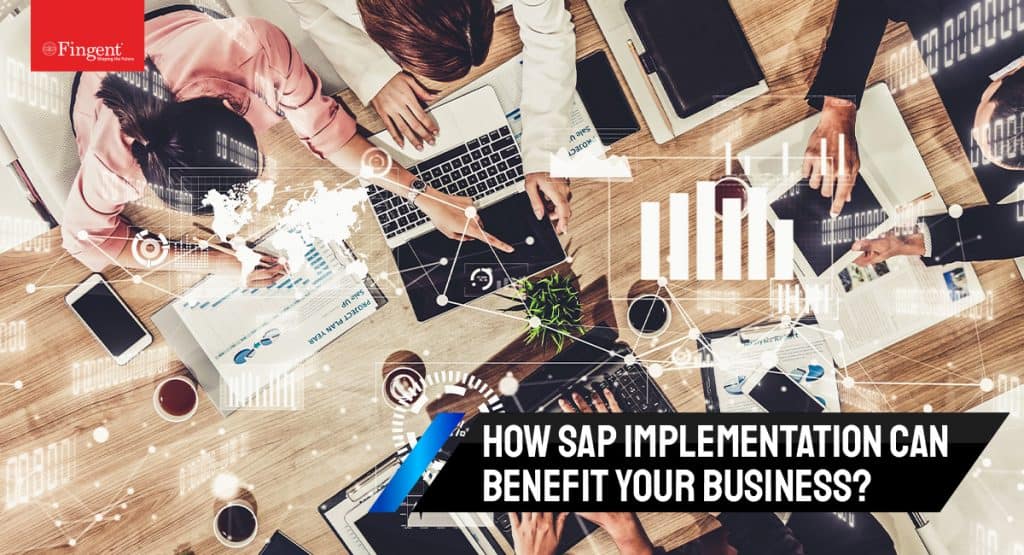
Fingent has the expertise to customize and implement SAP Business ByDesign for all sizes of businesses, across verticals such as professional services, manufacturing, real estate, retail, logistics, and so on. Our cloud ERP implementation services help transform your organization into an intelligent enterprise. We are a Silver Partner of SAP with 18+ years of experience in implementing SAP services and solutions. Our goal is to help you adopt the right technology that solves your business challenges without any complications. Contact us to understand how your business can benefit from SAP Business ByDesign.
Stay up to date on what's new

Featured Blogs
Stay up to date on
what's new



Talk To Our Experts
With proven expertise across 25 industries and an end-to-end suite of intelligent enterprise solutions, SAP has triumphantly cemented its position in the enterprise application software market. According to the World Economic Forum, SAP customers constitute 87% of total global commerce. Right from the R/2 commercial mainframe applications designed in the 1970s to the latest SAP S/4 HANA and its enormous suite of intelligent software products, SAP solutions have enhanced the competency of organizations with deep business insights and improved enterprise collaboration. SAP solutions include both technical and functional modules. While SAP ABAP, SAP Basis, SAP Security, SAP Solution Manager, CRM, etc. are technical modules, components such as Material Management (MM), Production Planning (PP), Financial Accounting and Controlling (FICO), etc. are examples of functional modules. All these modules of SAP closely integrate with each other to provide the best functionalities and solutions for businesses.
Read more: 8 ways SAP ERP software implementation helps your business

This post analyzes ABAP, one of the core technical modules of SAP, to understand how the platform enables businesses to run better.
What is SAP ABAP?
Advanced Business Application Programming or SAP ABAP is the principal programming language supported on the SAP NetWeaver ABAP server and the applications that run on it. Typical examples of ABAP-based applications include SAP ERP (previously known as R/3) and the present SAP S/4HANA.
SAP ABAP is the oldest and the most popular of SAP’s four key application platforms, together with SAP NetWeaver Java, SAP HANA, and SAP Cloud Platform. ABAP is used by SAP to deploy its applications on the NetWeaver ABAP platform. It’s different from the universal programming languages like Java because all ABAP programs and compiled code reside only in the SAP system. ABAP is renowned as the proprietary fourth-generation programming language (4GL) of SAP, developed to process massive volumes of data in SAP business applications.
ABAP enables businesses to customize their workflows related to material management, production management, supply chain management, financial accounting, and all other modules of SAP. This helps businesses reduce the time-consuming manual processes involved in data processing, particularly when they have more data to process.
Though some of the popular SAP applications such as SuccessFactors, SAP Ariba, SAP Business One etc. run on other programming languages, the role of ABAP is crucial, especially when these applications integrate with ABAP-based applications such as SAP ERP and SAP S/4HANA. As of 2021, there are five million registered ABAP developers worldwide, which indicates the robustness and credibility of the ABAP foundation for a wide range of SAP business applications.
Read more: SAP for Business-Making SAP support available at your hand

How does SAP ABAP accelerate business transformation?
ABAP was developed by SAP to enhance and expand the functionality of SAP systems. Here’s how ABAP is adding value to SAP users across the globe.
1. Aids mission-critical business processes
Since the 1980s, ABAP technology has been serving as the rock-solid foundation of SAP’s application portfolio. Several mission-critical business functions rely on ABAP for its scalability, robustness, and extensibility. ABAP is the underlying technology that steers SAP’s celebrated platforms and flagship suites such as SAP S/4HANA, SAP ERP (R3), and the next-generation data warehouse – SAP BW4/HANA. Thus, ABAP helps monitor and improve strategic business measures.
2. Enables customization of SAP business applications
Due to its availability as an independent platform, ABAP is primarily used to develop cutting-edge, bespoke SAP business applications. Custom ABAP development allows users to configure and tailor SAP modules based on their business requirements. Since the initial days of ABAP, SAP customers and partners have established a tradition of creating custom codes and add-ons that function effectively on the ABAP platform.
3. A holistic development platform
ABAP combines the innovative capabilities of SAP HANA (SAP’s in-memory database), the power and consistency of the ABAP server, and the digital UX potential of SAP Fiori (SAP’s UI technology). All these features make it a holistic development and runtime platform. Continuous developments by SAP make ABAP capable of addressing new business scenarios.
4. Reduces the development cost
ABAP offers a centralized, shared, and integrated development environment that allows multiple developers to work on the same development objects simultaneously. Hence, it’s easy to track the changes to development objects and push them to QA or production environments, without losing version control. The integrated, self-compiling nature of ABAP helps reduce the development cost.
5. Offers excellent development environment and tools
The key highlight of ABAP Platform 2021 (the underlying technology of SAP S/4HANA), is the ABAP Development Tools (ADT) that support the entire development lifecycle in Eclipse IDE. It improves the efficiency of developers and offers enhanced SAP HANA capabilities. ABAP Platform 2021 facilitates the seamless transformation of your existing SAP business suite to SAP S/4HANA (cloud or on-premise) and SAP BTP (Business Technology Platform).
6. Improved focus on user experience
ABAP RESTful Application Programming Model promotes the development of SAP HANA-optimized Web APIs, SAP UI5, and Fiori applications. ABAP development tools support browser-based, device-responsive, and role-based development of application functions. It enables users to switch to different devices and collaborate effortlessly.
Read more: Top 3 UI offerings from SAP: Fiori, Screen Personas, and Lumira

7. Extensible to the cloud
ABAP Platform 2021 has been improvised to create customized extensions in the cloud. The growing number of SAP customers who’re adopting SAP S/4HANA Cloud will benefit from ABAP’s tailored extensibility. The users will get access to more innovative features developed by SAP and can keep their software up-to-date with regular patches and upgrades.
8. Change and transport management
ABAP offers comprehensive change and transport management for the development projects organized in the ABAP Workbench and also helps in customizing those projects. It also facilitates to transport the changes between the SAP systems in your environment.
How can Fingent help your businesses unlock the potential of SAP ABAP?
ABAP is primarily a developer-friendly language. However, associating with the right SAP partner can help even the non-technical SAP users to master the technology. We’ve helped several businesses in identifying, customizing, implementing, and maintaining ABAP within their SAP systems. As a Silver Partner of SAP, we help customers cut their development efforts and costs, reduce technical complexities, and bridge skill gaps. Our SAP application development practice enables businesses and aces IT professionals to collaborate effectively and deliver cutting-edge enterprise applications across any platform, device, and tech stack in the shortest span.
Stay up to date on what's new

Featured Blogs
Stay up to date on
what's new



Talk To Our Experts
The pandemic put business challenges on an amplifier and made it look insurmountable. Here we all are though, crossing that barrier and making things work. Some challenges persist though. One area is the acceleration of the remote working scenario. Besides, sectors like manufacturing and Life Science have the challenge of accomplishing more tasks efficiently in less time.
This intimidating scenario drives the need for an intelligent enterprise. That’s exactly what SAP Business Technology Platform (BTP) empowers enterprises in all sectors. But what is SAP BTP?
This article describes what SAP BTP is. It also explains all that you must know about SAP BTP and how you can leverage it to grow your business and remain resilient.
Read more: It’s time to transform your business for the new digital age: Rise with SAP!
What is SAP BTP?
SAP BTP is an open platform as a service. It can integrate SAP and third-party applications and extend application capabilities. It can empower an organization to exploit data to solve its business problems.
SAP BTP can provide in-memory capabilities, core platform services, and unique microservices. It can help develop the exact application needed quickly, easily, and economically. All this without investing in local infrastructure.
It is a business-oriented technology platform for your SAP and third-party applications. It can unlock value and drive growth for its clients. SAP BTP unifies a plethora of technology stacks.
SAP BTP covers a wide range of functionalities. These range from document management to globalization, to blockchain and ML. Organizations can leverage SAP BTP services to automate business processes, manage decision logic. It also allows them to gain end-to-end process visibility.
But what is SAP BTP made of?
SAP BTP consists of four building blocks:
- Database and data management: This includes SAP HANA and SAP HANA cloud.
- Analytics: Including SAP Data Warehouse Cloud, SAC, and Business Objects BI.
- Application Development and Integration: Includes SAP Integration and Extension suites and SAP Process Orchestration.
- Intelligent Technologies: Including AI, ML, and IoT.
How Is SAP BTP Revolutionizing Business Operations?
SAP BTP can be used to build and extend SAP applications quickly. Here are the top three scenarios:
1. Integration
Most organizations prefer best-of-breed applications. With the journey to the cloud, the system landscapes are increasingly complex and business processes remain disconnected.
Today, most businesses have processes spanning from on-premise to cloud, and across multiple vendors. Plus, to complicate matters, some organizations continue to support their legacy applications along with various platforms and open-source technologies. SAP BTP allows seamless integration by simplifying development and quickening deployment.
Read more: Improve business planning with SAP Analytics Cloud!
These complex environments can only be managed with proper integration. While the value of these landscapes is decreasing, the complexity and cost of such integration are increasing.
SAP BTP can help organizations to refine and enhance their business operations along the entire value chain. It can do this by connecting applications, data, and experiences across SAP and beyond.
SAP Integration Suite uses a set of connectors and APIs to securely connect and integrate business processes. This can accelerate an organization’s time to value in a secure, sustainable, repeatable, and cloud-centric capability.
2. Data management
Today, we live in the age of data. But most organizations fail to get value from it. They gather the data and store it in disparate mediums. This only leads to a disrupted flow of information.
Your business success depends on how you analyze your data and what you do with the results. SAP BTP allows you to transform your data into value quickly and efficiently.
Data management is all about creating value from the data. If a business wants to exceed in today’s global economy, it must act on real-time business data. However, both the structured and unstructured data volumes create challenges for organizations.
Instead of accelerating digital transformation, data has become the anchor that is holding businesses in the old way of working. This has led to data swamps putting them in a worse position than they were ten years ago.
SAP BTP solutions are designed to provide flexible and user-first data management. It allows organizations to discover, connect, orchestrate data with internal and external data flows. This enables business leaders to access near real-time data and drive insight and value back into their businesses.
3. Extensibility
Businesses must continue to innovate rapidly if they want to stay relevant. During the pandemic, most businesses had to innovate their business models to adapt to changed circumstances such as local lockdowns and shortage of distribution chains.
As new businesses emerged with their reduced innovation cycles, they posed a serious threat to established businesses. Organizations must thus be empowered to build, extend, and enhance their application landscape so they can stay relevant while rapidly realizing new opportunities.
SAP Extension Suite allows organizations to access prebuilt extensions through an integrated digital marketplace. SAP BTP empowers businesses to speed up integration, find real business value from data, and extend SAP landscapes to innovate.
For example, let’s discuss the SAP Workflow Service. The SAP Workflow Service is part of the SAP BTP portfolio. This service allows businesses to extend their business processes. These extensions allow organizations to adopt business process changes quickly and in a non-disruptive way.
It provides unique monitoring applications that help monitor deployed workflows and their instances. Additionally, it also allows REST APIs to read, create, modify, or cancel workflow and task instances.
Integrating SAP Workflow Management with SAP Conversational AI allows organizations to leverage digital support for their workflows, process cycle times, recommendations. Plus, it allows them to reconcile both structured and unstructured workflows.
This can increase the level of automation enabling businesses to better manage overall complexity, reduce manual effort, and associated errors.
Read more:Top 7 benefits of adopting SAP Intelligent Robotic Process Automation
How can Fingent help leverage SAP BTP being SAP Silver Partner?
As SAP Silver partner, Fingent can apply design thinking and agile methods to develop industry apps on SAP BTP. We can help deliver innovative solutions with speed and agility.
When we combine our expertise at Fingent with SAP BTP, we can leverage disruptive technologies such as AI and predictive analytics and innovate across industries and business functions. This can help our clients extend capabilities, integrate intelligent technologies, generate actionable insights, and amplify results.
We can help our clients gain the flexibility of public or private cloud infrastructure to create an intelligent enterprise experience. Along with SAP BTP, Fingent can help your intelligent enterprise take a big step forward. Give us a call and let’s discuss how best we can help you.
Stay up to date on what's new

Featured Blogs
Stay up to date on
what's new













